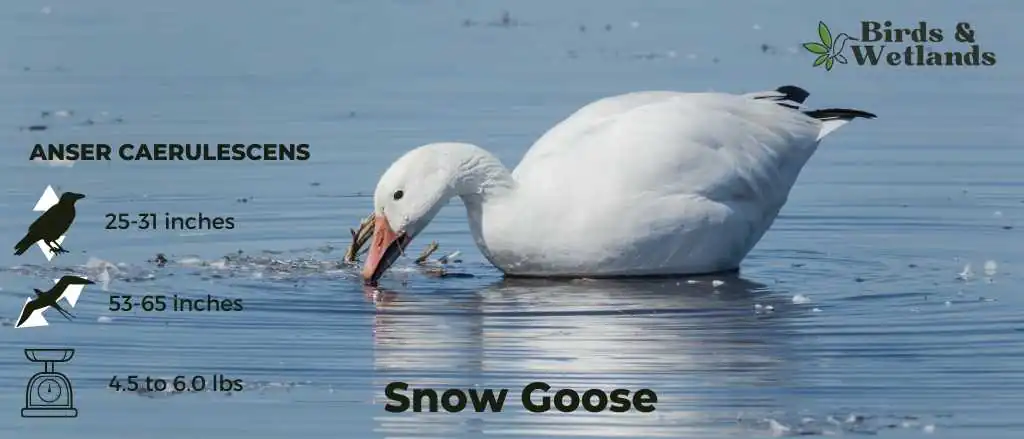The snow goose is known for its striking white plumage and thick, downy undercoat. This species exists in both light and dark morphs, the latter often referred to as the blue goose.
Snow geese are found throughout much of North America, including coastal regions of Alaska and eastern Canada, as well as parts of the western United States and along the Gulf Coast and northern Mexico.
With their long necks, heads stained rusty brown, black grin patch or grinning patch and webbed feet, these birds are well-adapted to aquatic habitats.
Snow Goose Description
The greater snow goose and lesser snow goose are two subspecies of snow goose that display a few key differences from each other.
The greater snow goose is typically slightly larger than the lesser snow goose, with slightly longer legs and a longer bill.
Unlike the lesser snow goose, which displays color dimorphism between white and dark-phase adults, the greater snow goose does not show such marked variation in its plumage.
Color Plumage Morphs
Both snow and blue phases have pink bills with black tomia, and rose-red feet and legs.
The white-phase geese are all-white except for black wing tips.
The appearance of the blue-phase snow geese is distinctive and easily recognizable. Unlike the white-morph snow goose, which has pure white plumage, the blue-morph goose has a white head and neck that contrasts sharply with its pale gray lower neck, breast, and belly.
Additionally, its upper parts and flanks are ash gray-blue, while its ventral area, tail coverts, and rump are all completely white. Its wings bear additional shades of grey as well as some areas of white along the primaries. The striking blue plumage starkly contrasts the dark brown eyes of this unique bird species.
When the white-morph and the blue-morph snow geese interbreed, the offspring they produce may be of either morph. These color morphs were previously believed to be different species.
Today, these two color morphs are recognized as phases of the same species due to their tendency to interbreed and live within their range.
The color phases are determined genetically. The dark phase is caused by a single dominant gene, whereas a homozygous recessive gene causes the white phase.
Young birds have been observed to select a mate whose coloring resembles their parents. If the geese were hatched as a heterosexual pair, they would mate with either color phase.

Listen to Snow Goose
The sound of the snow goose is both distinctive and highly recognizable. More nasal than many other bird calls, the Lesser Snow Goose’s distinct whistle has been likened to the sound of a barking dog or loud honking noise.
This call tends to be most frequent in chorus, where multiple geese can be heard calling at once. While the snow goose may not be a particularly vocal species overall, its unique whistle is certainly one sound that no true nature lover will ever forget to hear.
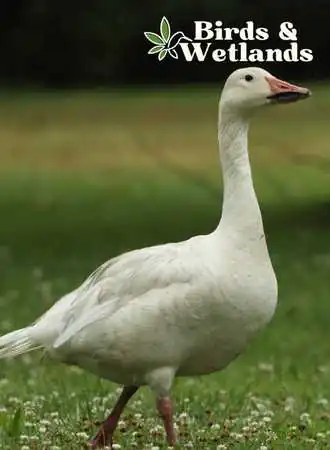
Snow Goose Diet
Unlike many other types of geese, snow geese do not rely exclusively on aquatic sources for sustenance; instead, they often wade through shallow water or walk along the shoreline to pick up ground-dwelling plants and other small organisms.
Additionally, these geese are typically found feeding in large flocks, which allows them to search for food more efficiently and intimidate potential predators.
Snow geese feed primarily on plant material, eating seeds, winter wheat, pasture grasses, leaves, marsh grasses and roots of various types of grass, sedges, bulrushes, horsetail, and other plants. These geese eat berries during the fall months when they have migrated south.
During the winter, snow goose flocks often feed on waste grain in agricultural fields in their wintering grounds.
Thanks to their varied diet, snow geese can thrive in different locations, climates and conditions.
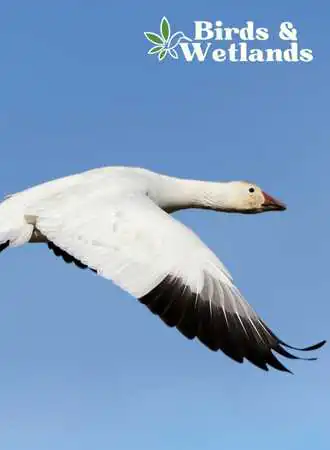
Snow Goose Habitat
Snow geese breed in the arctic tundra, a harsh and unforgiving environment.
During the summer months, these geese make their home on the vast landscapes of northern Canada and Alaska, foraging for food in the sparse vegetation around them.
However, as winter approaches, these majestic birds fly south to warmer regions where they can find abundant food sources and milder temperatures. Their wintering areas include coastal marshes and muddy fields.
Typically, family groups will head out to coastal areas or wet meadows and graze on grasses and other plants near waterways.
Their habitat of choice may vary throughout the year depending on what is available in each seasonal period. Still, one thing remains constant — wherever snow geese choose to spend their time, they are sure to live in spectacular beauty and comfort.
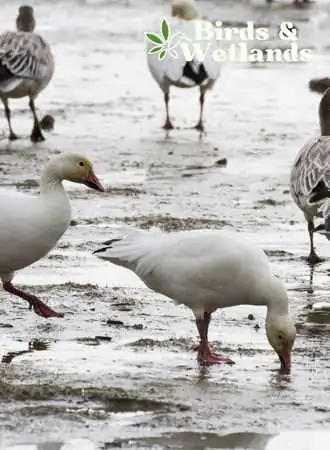
Snow Goose Range
There are nesting colonies of snow geese in the northern regions of Canada, particularly British Columbia and northern parts of Alaska near the Arctic.
Winter & Spring Migration
The lesser snow goose is a migratory species of waterfowl that undertakes an incredible journey each year. During the winter, these geese leave their nesting areas and migrate along narrow corridors to specific locations across North America, traveling thousands of miles to reach their destination.
The primary destination for these birds is the Central Flyway, a migration route from mid-United States to northern Mexico. Along this route, the lesser snow goose passes through several different flyways and traverses prairies, grasslands, and agricultural fields in search of food and shelter.
In addition to the Central Flyway, the lesser snow goose also travels through two other important flyways: the Mississippi Flyway and the Pacific Flyway. These routes take these graceful birds across wide expanses of grassland and farmland as they make their way to their wintering grounds on coastal plains. Some flocks spend winters in Skagit River and Fir Island.
As they travel along each of these different routes, they depend on rich sources of food and shelter provided by farmers and other residents living in rural areas.
The greater snow goose is a large, long-distance migratory bird that spends its winters in several different locations along the eastern seaboard.
Some flocks of greater snow geese migrate through the Atlantic Flyway and spend their entire winter along the Atlantic coast. Other flocks travel further inland, venturing to coastal plain regions such as those found in Delaware, Maryland, Virginia, and North Carolina.
These areas provide ample open grasslands for the remaining flock to gather on during their long winter months. In addition to being able to find food searches and shelter from harsh conditions, these key habitats also support other species that share this precious range.

Vagrancy in Europe
Given the rarity of snow geese in Europe, it is no surprise that they are often considered to be vagrants. However, escapes from captivity and the activity of feral populations have resulted in occasional sightings of these geese across the continent.
In addition to regular sightings among flocks of other waterfowl species like brant, barnacle goose, and greater white-fronted goose, there is also a thriving feral population of snow geese in Scotland that contributes to these vagrant sightings.
Snow Goose Nesting & Mating
Snow geese are known for their preference for colder climates, and as such, they exhibit several unique behaviors regarding mating and nesting.
In particular, these geese breeding occurs during the late spring and summer months in their Arctic breeding grounds, typically between May and August. During this time, snow goose nesting behavior becomes most prominent, with these birds building their nests on the ground in large colonies with Canada goose breeding flocks and other wildlife.
The lesser snow geese breed along Banks Island, Queen Maud gulf, Victoria Island, Baffin Island, Hudson Bay, Northwest Territories and parts of northeast Canada. The nest is usually a shallow depression lined with various types of plant matter such as moss, animal down, and grass to cushion the eggs.

Adult females lay up to 6 creamy white eggs that measure 78 x 52 mm in size and with an average weight of 127 grams. The female incubates her eggs for around 22 to 25 days while the male surveys the nest site.
Once the eggs have hatched, both parents will help to care for the goslings or immature birds by providing warmth, food, and protection. Goslings often leave the nests few hours after hatching. The young fledge within 45 days from hatching.
When young snow geese are still young and fluffy, they get their final plumage at around 42 to 50 days. During this time, they remain near their parents and rely on them for guidance and care.
After this initial period of dependency, the geese then stay with their parents and family group through the next breeding season until they reach sexual maturity at two years of age.
However, it typically takes young geese several years before they start breeding, as they don’t normally reach their sexual prime until three or four years of age.
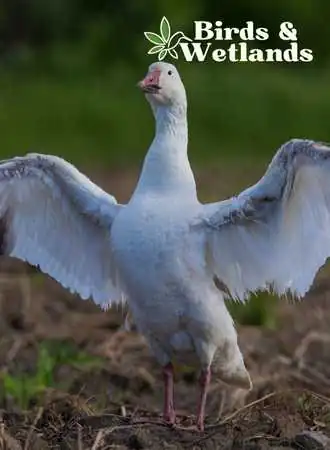
Snow Goose Population & Conservation
The estimated population of snow geese in North America is currently at record highs, with more than 5 million birds in the breeding population. This significant increase can be traced back to changes in land usage in the 20th century, as forests and prairies were converted to agricultural areas.
Many snow geese prospered due to these changes, resulting in today’s booming snow goose population.
Over the past several decades, the North American snow geese population size has boomed, leading to widespread environmental damage due to overgrazing and other habitat destruction.
To address this issue, the U.S. Fish and Wildlife Service have implemented several strategies to mitigate their exploding numbers. These include increasing hunter bag limits, extending hunting seasons, and using additional hunting methods.
While these efforts have seen some success in decreasing the overall population levels of snow geese, they have not fully reversed the trend. Despite these ongoing efforts, it remains to be seen whether these changes will ultimately prove successful in managing North America’s booming snow goose population.
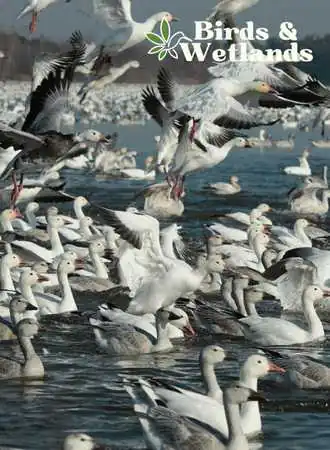
Key Takeaways
The snow goose species are known for its white plumage, pink bill and downy undercoat.
The dark morph is called blue geese.
The white morph or white geese is pure-white except for the black wingtips which are barely visible while on the ground.
Previously, they were thought to be two separate species.
Snow geese are found throughout much of North America, including coastal regions of Alaska and eastern Canada, as well as parts of the western United States and northern Mexico.
The snow goose is closely related to Ross geese.
With their long necks and webbed feet, these birds are well-adapted to aquatic habitats.
The greater snow goose is typically slightly larger than the lesser snow goose, with slightly longer legs and a longer bill.
Lesser snow geese nest in colonies and large flocks and females lay up to two to six eggs. While the greater snow goose nests farther north.

